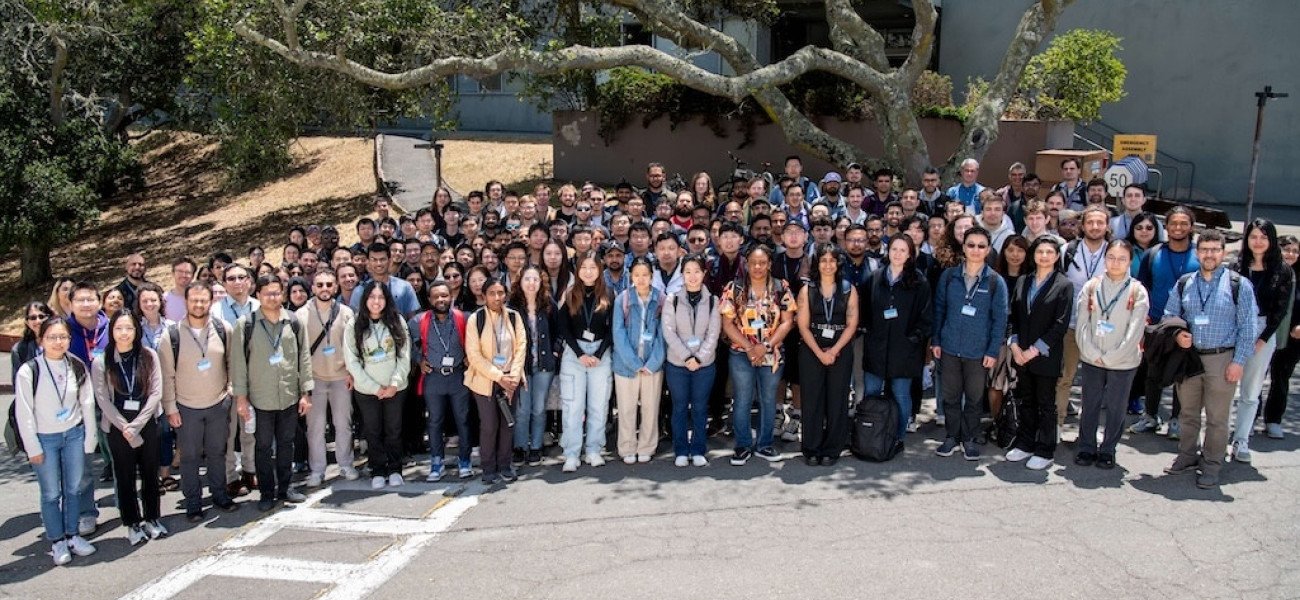
The DL4Sci 2025 cohort met in person at Berkeley Lab. - Credit: Berkeley Lab
Over 170 researchers and engineers gathered at Berkeley Lab June 23–27 for the Deep Learning for Science School (DL4Sci), learning from AI experts and preparing for the role of deep learning in their own work. First hosted by Berkeley Lab Computing Sciences in 2019, the five-day immersive program offered scientists the opportunity to explore the latest advances in deep learning and generative AI (GenAI).
AI approaches, many of which are powered by deep learning, are an increasingly useful set of tools in science research, and DL4Sci teaches researchers the skills they need to incorporate this technology into their work. In some cases, AI can drastically accelerate the pace of scientific discovery. Events like DL4Sci are among the ways in which Berkeley Lab is investing in the future of science research.
“The six years since our first DL4Sci school have seen an explosion in powerful techniques for generative deep learning, as well as clear demonstrations of their potential in science applications. However, it’s a rapidly changing field. This year's school was a chance for scientists to meet with world experts to get a grounding in GenAI fundamentals as well as the latest techniques and computational approaches,” said Wahid Bhimji, Division Deputy for AI and Science at the National Energy Research Scientific Computing Center (NERSC) and a co-organizer of the event. “It was also a chance for AI-minded early-career scientists to meet, have fun, and forge the next generation of collaborations that will transform science.”
DL4Sci 2025 featured in-depth lectures, research talks, and hands-on tutorials on state-of-the-art techniques including transformers, large language models, diffusion models, and Agentic AI, as well as practical sessions including best practices for running deep learning at scale on high performance computing (HPC) systems.
"We’re at a turning point where AI is changing how science is done – but only if we train a generation of researchers who understand both the promise and the principles behind these tools,” said Berkeley Lab Scientific Data Division Director Ana Kupresanin. “Programs like DL4Sci help make sure that future advances are built on a strong foundation of scientific rigor, thoughtful design, and trustworthy data."
To ensure students got that key training, DL4Sci organizers had students get their hands (metaphorically) dirty with practical application. In addition to lectures on cutting-edge techniques by international experts from both industry and academia, the instructors led interactive labs and offered state-of-the-art code and content. Among other networking opportunities, over 60 attendees presented at a poster session focused on AI developments and DOE-relevant applications. At the end of the week, attendees came away with a new background in what GenAI is, the types of problems it excels at, and how to choose, build, train, and deploy GenAI models for scientific applications.
According to NERSC director Sudip Dosanjh, who oversees the use of the DOE’s most widely used supercomputer for science research, events like DL4Sci are an investment in future science outcomes, with direct results due to the increasing reach of AI in many scientific disciplines.
"NERSC has had many deep science engagements focused on AI. Since NERSC has over 11,000 users, taking lessons from these engagements and training the broader user community is a key part of our strategic plan,” said Dosanjh. “We have seen an order-of-magnitude increase in the number of users employing AI at NERSC and we expect AI to become pervasive in the coming years. Events such as DL4Sci are critical to ensure that AI impacts a broad set of DOE science areas."
The effects of that influence are already evident, with significant breakthroughs in particular fields that are especially well-suited to AI. But as more scientists have the skills to incorporate deep learning into their research workflows, said event co-organizer Ben Erichson, a scientist in the Scientific Data Division at Berkeley Lab, the benefits of AI in science research are likely to become widespread.
“GenAI is not only one of the fastest-growing areas in AI, but its probabilistic nature and flexibility make it particularly well-suited to scientific problems,” said Erichson. “As highlighted throughout DL4Sci, it is already being applied in domains ranging from drug and materials discovery to genomics and the modeling of high-dimensional dynamical systems. As more scientific disciplines generate and open up large-scale datasets, we can expect GenAI to see even broader adoption across the sciences, driving innovation and scientific discovery.”
About NERSC and Berkeley Lab
The National Energy Research Scientific Computing Center (NERSC) is the mission computing facility for the U.S. Department of Energy Office of Science, the nation’s single largest supporter of basic research in the physical sciences.
Located at Lawrence Berkeley National Laboratory (Berkeley Lab), NERSC serves 11,000 scientists at national laboratories and universities researching a wide range of problems in climate, fusion energy, materials sciences, physics, chemistry, computational biology, and other disciplines. An average of 2,000 peer-reviewed science results a year rely on NERSC resources and expertise, which has also supported the work of seven Nobel Prize-winning scientists and teams.
NERSC is a U.S. Department of Energy Office of Science User Facility.
Media contact: Email our communications team ⟶